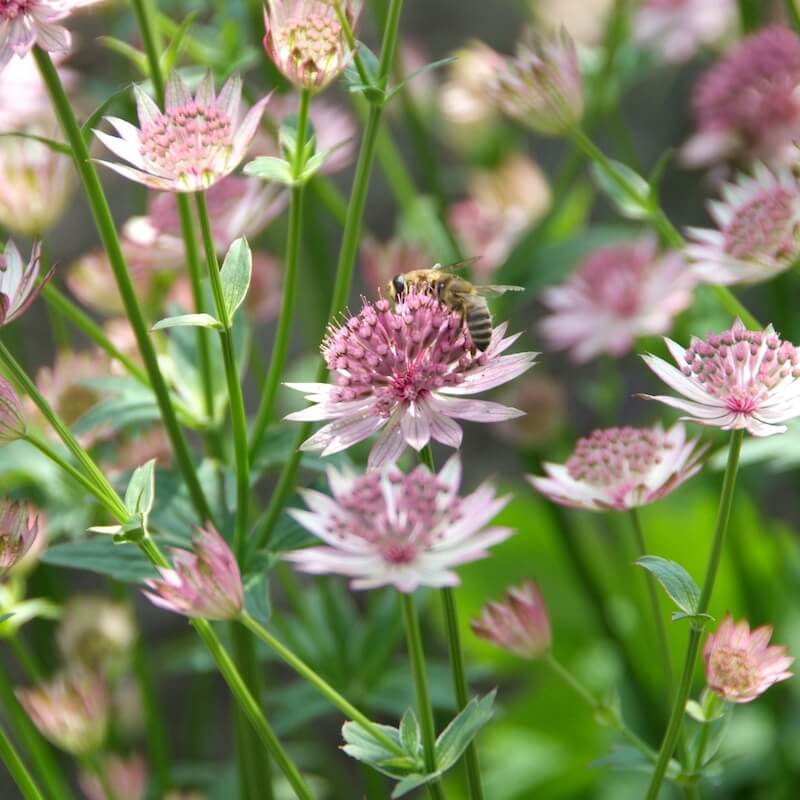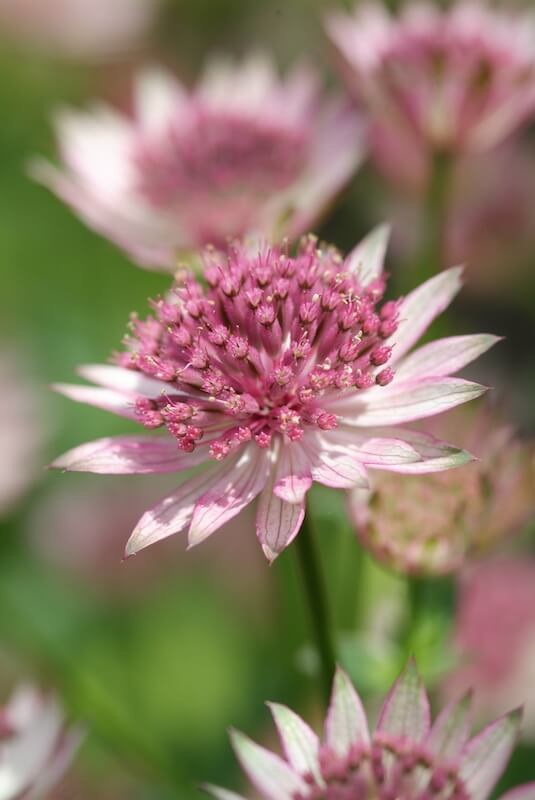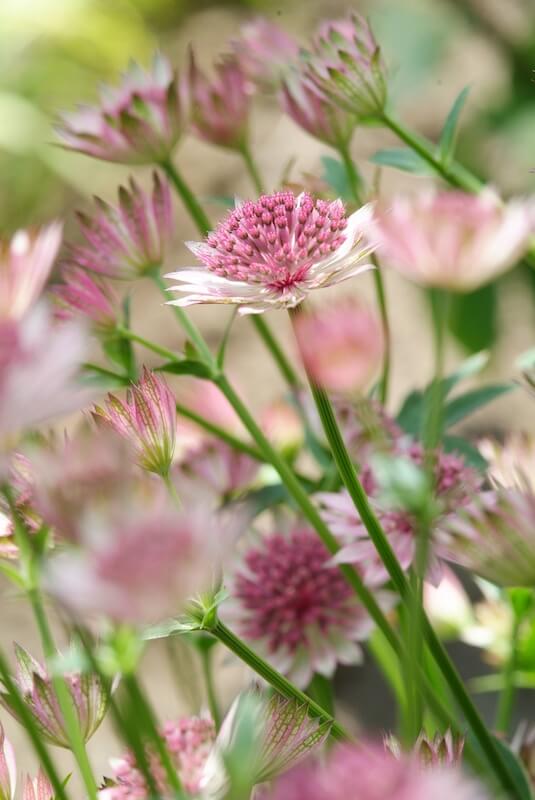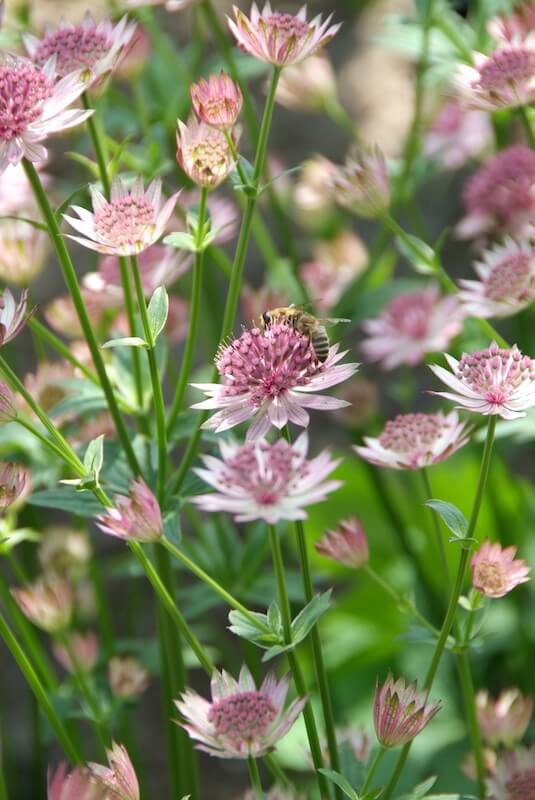Why Astrantia Roma Should Be in Every Cottage Garden
Astrantia major Roma, Masterwort Roma

Position
- Prefers partial shade but grows well in sun if the soil is consistently moist
- Excellent for borders, cottage gardens, pond or stream margins, and woodland edges
- Combines beautifully with ferns, hostas, and other moisture-loving perennials
Hardiness
- Hardy down to at least –20°C (–4°F)
- Well-suited to all except the coldest or most exposed UK gardens
Soil
- Thrives in rich, moisture-retentive but well-drained soil
- Performs best in ground improved with compost, leaf mould, or well-rotted manure
- Avoids very dry or thin soils unless improved for moisture retention
- Tolerates acid, neutral, or alkaline soils
- Versatile and adaptable for most UK garden soils
- Grab a soil test kit and ensure the perfect conditions for growth
Height
- Typically reaches 60–80 cm (2–2.5 feet) over 5–10 years
- Forms neat clumps of upright, branched stems with dense foliage
Seasons of Interest
- Foliage: Deep green, deeply-divided leaves create ground cover from spring through autumn
- Autumn Colour/Variegation: Leaves fade yellowish in autumn; no variegation present
- Flowering: Airy stems carry domed rosy-pink flowers from late May or June through September, often with a long and repeat-flowering period
- Flowers are very attractive to pollinators, particularly bees and butterflies
Additional Notes
- Deadhead to prolong flowering and prevent unwanted self-seeding
- Mulch in spring with compost or leaf mould to preserve moisture and enrich the soil
- Water freely in dry periods, especially during summer heat or for young plants
- Disease- and pest-resistant, requiring little regular attention
- Divide clumps every few years in spring or autumn if needed
- Excellent as a cut flower for both fresh and dried arrangements
Astrantia Roma - Perfect Perennial for Long-Lasting Blooms
If you’re looking for a beautiful and hardworking perennial to brighten your garden, Astrantia Roma might just be your new favourite. This long-flowering masterwort is a brilliant choice for gardeners who love soft pink blooms, low-maintenance plants, and a cottage garden aesthetic. Whether you’re new to Astrantias or already a fan, this variety is worth discovering.
What makes Astrantia Roma so special?
Roma is a particularly vigorous form of Astrantia major, known for its long flowering season and soft pink blooms. Unlike many other varieties, Roma produces flowers after flowers from late spring through to early autumn. Its pale, papery bracts and pincushion-like flowers appear on wiry stems that seem to float above the foliage. The flowerheads themselves last for weeks and are excellent as cut flowers.
What sets Astrantia Roma apart is its adaptability. It grows well in full sun or partial shade, thrives in moist or well-drained soil, and is suitable for both formal borders and informal cottage garden settings. Its soft pink flowers mix beautifully with ornamental grasses, hostas, ferns, and hardy geraniums, adding a romantic touch to any planting combination.
How long does Astrantia Roma bloom?
One of the standout features of Astrantia Roma is its long flowering period. From late spring to early autumn—typically June to September—you’ll enjoy a steady succession of blooms. Deadheading faded flowers encourages more flowers to form, keeping the plant looking tidy and prolonging the display.
Unlike some perennials that bloom and fade quickly, this herbaceous perennial puts on a long-lasting show. That makes Roma perfect for gardeners seeking continuous colour without too much effort. It’s gratifying when grown in moist, well-enriched soils with organic matter.

What are the flowers of Roma like?
The flowers of Astrantia Roma are a delight. Each flowerhead consists of a central cluster of tiny blooms surrounded by a ring of pointed, papery bracts. These bracts are soft pink, often with slightly darker tips, giving the blooms a pincushion-like look. This explains its common name—Hattie’s pincushion.
Roma’s blooms are borne on wiry stems that rise above deeply lobed green foliage. These delicate-looking but sturdy stems sway gently in the breeze, adding movement and softness to your borders. The soft pink flowers make excellent companions for ornamental grasses and other pastel-toned perennials.
Where should I plant Astrantia Roma?
Roma is incredibly versatile. It thrives in well-drained or consistently moist soils, making it ideal for woodland edges, mixed borders, or shady spots. It prefers moist, humus-rich conditions but can also tolerate drier soils if it’s well-established. Adding mulch, manure, or garden compost can help retain moisture and improve soil texture.
You can plant it in full sun, partial shade, or part shade. In sunnier locations, make sure the soil doesn’t dry out completely. If you garden on heavy clay or fast-draining sand, enrich the planting area with a generous amount of compost before planting.

Does Astrantia Roma grow well in a cottage garden?
Absolutely. With its soft pink flowers, airy stems, and relaxed growth habit, Roma complements any cottage garden scheme beautifully. It weaves through other plants, filling gaps without overwhelming its neighbours. The plant forms a neat clump and returns reliably year after year.
Pair it with other classic cottage garden favourites like hardy geraniums, astrantias in different colours, delphiniums, and foxgloves. The romantic feel of its pincushion-like flowers and deeply lobed foliage makes it a staple for gardeners looking to create informal, flower-filled borders.
What care does Roma need through the seasons?
Like many herbaceous perennials, Roma dies back in winter and re-emerges with fresh new growth in spring. In the autumn, you can cut the plant back to ground level once the foliage has turned yellow. This keeps borders tidy and allows space for spring bulbs and early bloomers.
In spring, apply a mulch of compost or well-rotted manure around the clump. This enhances moisture retention and supplies nutrients for robust growth. Keep the area free of weeds and watch for the first shoots to appear. With regular watering and occasional feeding, your plant will thrive.
What does PBR mean for Astrantia Roma?
You may have seen the letters PBR (Plant Breeders’ Rights) associated with Astrantia Roma. This simply means that the variety is protected, and propagation without permission is not allowed. It ensures the breeder maintains control over the quality of plants sold.
So if you want to grow Roma, buy it from a reputable nursery or garden centre. This guarantees that you’re getting the genuine, healthy stock that has been propagated under license. Look out for the PBR label when you shop, and avoid dividing or sharing the plant without permission.
Is Astrantia Roma RHS approved?
Yes, Astrantia Roma has received the RHS Award of Garden Merit (AGM). This means it’s been tested by the Royal Horticultural Society and proven to perform well under UK conditions. Plants with the AGM are reliable, decorative, and easy to grow.
This award provides additional reassurance for gardeners seeking high-quality plants with dependable performance. Whether you’re planting a new bed or refreshing an established border, Roma is a great choice that delivers consistent results.
Can Astrantia Roma tolerate different soil types?
Yes, one of Roma’s strengths is its adaptability. It grows happily in well-drained soil and can tolerate drier conditions once established. However, it performs best in moist, humus-rich soil with plenty of organic matter. If your soil dries out quickly, add compost to boost water retention.
In clay soils, ensure the planting hole drains freely to prevent root rot. You can lift the planting area slightly or mix in grit and compost to improve the conditions for sandy soil. Mulch well and water regularly during dry spells.
What should I plant with Roma for the best effect?
For a dreamy, long-lasting display, combine Roma with soft-toned perennials and grasses. Its pale pink flowers blend perfectly with astrantias in white or red shades, while its wiry stems add height and structure. Try planting it alongside ornamental grasses for contrast, or weave it through a border of blue salvia and campanulas.
In a cottage garden, Roma looks charming with foxgloves, hardy geraniums, delphiniums, and roses. Its flowering season from June to September makes it a reliable companion for many other summer bloomers. If you love pink or red perennials, you’ll find Roma helps tie your planting scheme together beautifully.
From Darren’s Patch
Astrantia Roma is one of those plants I always return to when designing borders—its refined charm and dependable performance never fail to disappoint. I love how the soft pink, papery flowers seem to hover above the foliage on those wiry stems, adding both height and lightness to a planting scheme. In my garden, I tuck it into part-shaded spots where it happily mingles with ferns, hardy geraniums, and ornamental grasses. It brings that classic cottage garden softness without ever feeling overblown. Additionally, the fact that it blooms for months with minimal effort makes it a true stalwart. If you’ve got a patch of consistently moist soil, give Roma a home—you won’t regret it.
![]()
Key Points to Remember
- Astrantia Roma is a herbaceous perennial with soft pink, pincushion-like flowers and papery bracts
- It blooms from late spring to early autumn (June to September) and responds well to deadheading
- Grows best in moist, humus-rich soil but tolerates well-drained conditions once established
- Performs in full sun or partial shade, and suits woodland edges, borders, or cottage garden planting schemes
- Has the RHS Award of Garden Merit and is protected under PBR (Plant Breeders’ Rights)
- Looks stunning with ornamental grasses, hardy geraniums, and other classic cottage plants
- Forms a neat clump and returns every year with fresh new growth
- Requires compost or mulch in spring and can be cut back in autumn
- Great as a cut flower and loved for its long-lasting floral display
Astrantia Roma thrives in partial shade in moist, fertile, well-drained soil of any pH and can endure temperatures as low as –20°C (–4°F). It grows to 60–80 cm (2–2.5 ft) over 5–10 years and blooms reliably from May to September, with domed, blush-pink flowers. With spring mulching, regular watering, and very low maintenance, it’s a superb addition to UK gardens—especially for borders, wildlife-friendly plantings, and long-season colour.
Check out the RHS article here.
If you like this one, you’ll love Astrantia major Shaggy. Click here to explore it
For more information on perennials for your garden, please click here.

Frequently Asked Questions
Q: What is Astrantia Roma, and how does it differ from other astrantias?
A: Astrantia Roma, also known as Astrantia major Roma, is a clump-forming herbaceous perennial admired for its long-flowering soft pink blooms. Often referred to as masterwort or Hattie’s pincushion, this PBR (Plant Breeders’ Rights) variety features distinctive pincushion-like flowers with papery bracts on wiry stems. It is a vigorous and robust selection, noted for blooming from June to September. Roma is especially popular in cottage garden settings and contrasts beautifully with ornamental grasses. Its prolonged flowering season and RHS Award of Garden Merit make it a superior choice among pink or red astrantias.
Q: Where is the best place to plant Astrantia Roma in the garden?
A: Astrantia Roma thrives in woodland borders, mixed perennial beds, or cottage garden schemes. It prefers a position in full sun or partial shade, ideally with consistently moist, well-drained soil. It’s particularly well-suited to areas enriched with organic matter, such as garden compost or well-rotted manure. While it tolerates full sun, partial shade helps prevent the soil from drying out too quickly, especially in summer. Plant Astrantia Roma where its soft pink flowers can contrast with bolder foliage or mingle among other shade-tolerant perennials.
Q: How should I care for Astrantia Roma throughout the year?
A: Astrantia Roma is a low-maintenance perennial once established. In early spring, apply a mulch of organic matter to retain soil moisture and suppress weeds. Feed with a balanced, slow-release plant food as growth begins. Deadheading spent blooms encourages further flowering through the summer months. In autumn, once the perennial dies back, cut stems down to ground level. Fresh new growth will emerge the following spring. Ensure the plant remains in consistently moist soils, particularly during dry spells. Dividing every few years will rejuvenate clumps and maintain vigour.
Q: When does Astrantia Roma flower, and for how long?
A: Astrantia Roma begins flowering in late spring and can bloom continuously from June to September, especially with regular deadheading. Its long-lasting pincushion-like flowers, in shades of soft pink with green tinges, sit atop wiry stems and add elegance to any border. The long flowering season makes Roma particularly valued by gardeners seeking extended interest. Blooms are also excellent as cut flowers and retain their papery form well, both fresh and dried.
Q: What soil conditions does Astrantia Roma prefer?
A: Astrantia Roma flourishes in moist, well-drained soil enriched with organic matter. It prefers soil that remains consistently moist, particularly during summer, yet avoids waterlogging. While it tolerates a range of soils, adding compost or well-rotted manure at planting time improves structure and nutrient content. Astrantias are ideal for gardens with a slightly acidic to neutral pH and respond well to mulching in spring. Avoid planting in dry soils or overly exposed, sun-scorched spots.
Q: Is Astrantia Roma suitable for wildlife gardens?
A: Yes, Astrantia Roma is an excellent choice for wildlife-friendly gardens. The nectar-rich flowers attract a variety of beneficial insects, including bees, butterflies, and hoverflies. Its long flowering period provides a valuable food source over many months. The plant’s naturalistic appearance also integrates beautifully into wildlife planting schemes and informal borders, making it both ornamental and ecologically supportive.
Q: Can Astrantia Roma be grown in containers?
A: While primarily used in borders, Astrantia Roma can be grown in large, deep containers, provided it receives consistent moisture. Use a high-quality, peat-free compost enriched with organic matter, and ensure the container has good drainage to prevent root rot. Place in part shade and feed with a slow-release balanced plant food in spring. Regular watering is essential—never allow the compost to dry out completely, especially during warmer months.
Q: Where can I buy Astrantia Roma?
A: Astrantia Roma is widely available from reputable UK garden centres, specialist nurseries, and online plant retailers. When purchasing, look for healthy, well-rooted plants or bare-root divisions in season. As it is a PBR variety, ensure you’re buying from a licensed source. Online availability is particularly useful if you are seeking specific sizes or want to purchase during the bare-root planting season.
